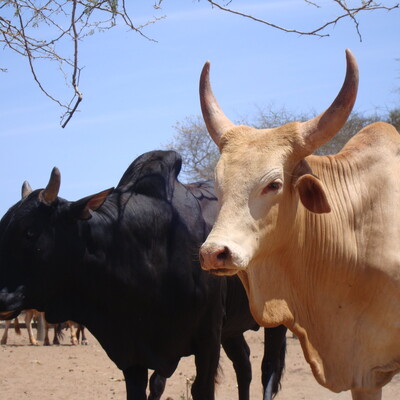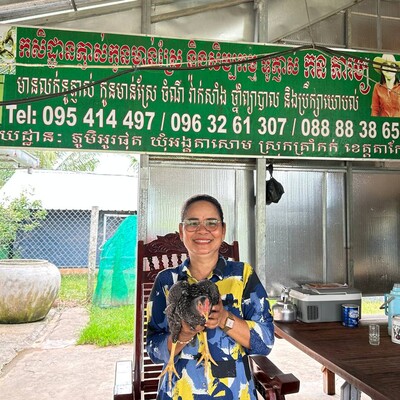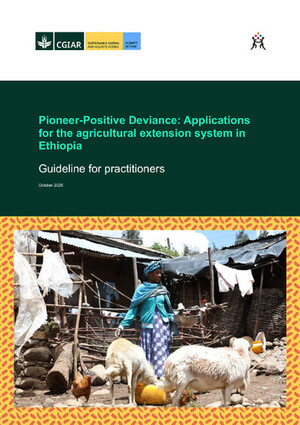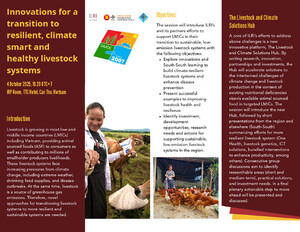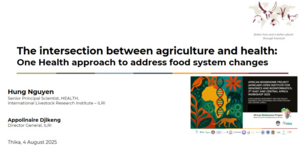
ILRI Impact at Scale program shares insights on scaling tools and practices with CGIAR science leaders and GIZ scaling experts
This post was written by Murat Sartas and Saba Ermyas, and edited by Paul Karaimu.
The International Livestock Research Institute (ILRI) Impact at Scale (I@S) program recently share examples for identifying, analysing and integrating scaling tools into agricultural research for development programs.
At an October 2020 scaling webinar for the science leaders community, which was co-organised by GIZ Task Force on Scaling and CGIAR Science Leaders Group, Iddo Dror, leader of the I@S program, shared real-life learnings from the program’s analysis of scaling tools and practices with CGIAR science leaders (see a related report here). He also presented the program’s and the CGIAR Research Program on Livestock’s first-hand experiences in blending advanced scaling and innovation tools within CGIAR for assessing unique frameworks and advising on selection of scaling tools and practices for projects and programs.
 The ILRI Impact at Scale framework (credit: ILRI).
The ILRI Impact at Scale framework (credit: ILRI).
Since late 2019, I@S has been testing and validating the Scaling Framework together with the CGIAR Research Program on Livestock (Livestock CRP). The Scaling Framework synthesizes approaches and tools developed within and outside CGIAR such as the Scaling Scan, ASAT and Scaling Readiness. The process starts with preliminary data collection about the project that wants to scale innovations. This is followed by meetings with the core project team to present the framework and the tools, to discuss the project’s vision of success and agree on the scope of the work, which is then articulated into a study plan. The study plan can include one, two or all three I@S Scaling Framework modules.
The first module is a ‘light track’. In the light track, following the scaling plan, a series of scaling workshops are organized. Participants include key project stakeholders such as government and national partners, private sector organizations and other international organizations working in the areas the project operates. Using the adjusted tools of Scaling Scan and ASAT, a validated scaling ambition for the project is formulated and several scaling ingredients and pathways are identified. Projects teams aiming to consolidate their overall scaling strategy and develop shared understanding among the team members and key project stakeholders might choose to finish the I@S study process with the light track.
The second module is the ‘standard track’. In addition to the light track, the standard track includes a deep dive into the Scaling Readiness tool. In consultation with the project team, the I@S team profiles the key characteristics of the project design and the relevance of the project for achieving impact as well as the innovation the project aims to develop or test. Afterwards, the I@S team guides the identification of the set of innovations that need to be combined to achieve scaling of the project innovations and profiles the ‘innovation package’. Scaling Readiness is based on specific definitions of innovations and uses existing evidence sources such as journal articles, books, book chapters and technical reports to assess the maturity and use of the innovations. It documents all resources that provide evidence for the maturity and use of innovations of the project for the specific contexts in which the project operates and the complementary innovations necessary to scale the project innovations in an evidence appendix. In cases where evidence is unavailable, a set of interviews complement the evidence claims. Scaling Readiness produces a scaling readiness report and a scaling plan for addressing the scaling bottlenecks identified in the scaling readiness report. Project teams that are looking for evidence-based site-specific recommendations for scaling strategies and activities might choose to finish the I@S framework with the standard track.
The third module is the ‘extended track’. The extended track includes support for scaling projects in implementing the scaling plan. Based on the specific needs of the project, the implementation support is customized. It can include dashboards that can provide updates about the performance of the implementation of the scaling plan, and additional elements that inform about project management and partnership aspects. It can also include recommendations for preparing scaling activities in the planning of work and budget documents, and recommendations for preparing new project proposals for complementing the project or for the next phase of the project. The extended track links the findings of the scaling study with implementation teams and organizational support services of the project partners. I@S uses state-of-the-art digital tools (such as Microsoft Dynamics, Teams, Power BI, Decisions, Smartsheet, Session Lab, etc.) in preparing the dashboards using live real-time data from core CGIAR systems so that the extended track can contribute to overall capacity development of the project teams and the hosting organizations of the projects in the long term. Project teams that want to benefit from the full package of the scaling support services choose the extended track.
At the webinar, other CGIAR scaling specialists including Marc Schut of CGIAR’s International Institute of Tropical Agriculture (IITA) and Wageningen University, Maria Boa of CGIAR’s International Maize and Wheat Improvement Center (CIMMYT) and Christiano Rossigloni of CGIAR WorldFish, also shared the scaling ambitions for their tools and practices, the solutions the tools developed for collecting evidence and generating information, and the limitations of their tools and practices.
The webinar also included a presentation by Julian Colomer, senior manager results and program performance at the CGIAR System Management Office. He said that the insights from the webinar and subsequent discussions can contribute to designing and developing the CGIAR stage gating process more effectively in 2021 and onwards.
GIZ’s Steffen Entenman appreciated the insights from the experiences of the I@S program in designing, testing and developing a scaling framework for a CGIAR centre.
ILRI I@S will continue advancing its scaling framework by adding new project, innovation and stakeholder management modules such as the collaborative project management design platform using Smartsheet; automated analysis and customized advanced data collection and visualizations using Microsoft Dynamics and Power BI platforms as well as a social network science-based fit for purpose partnership management tool. For more information contact i.dror@cgiar.org
Download Dror’s presentation: https://hdl.handle.net/10568/111134
More about the webinar can be found in this brief.
Read a recent case example from the ILRI I@S Framework: Scaling Readiness report and scaling plan for training and certification approach for small-scale pig producers in Uganda







